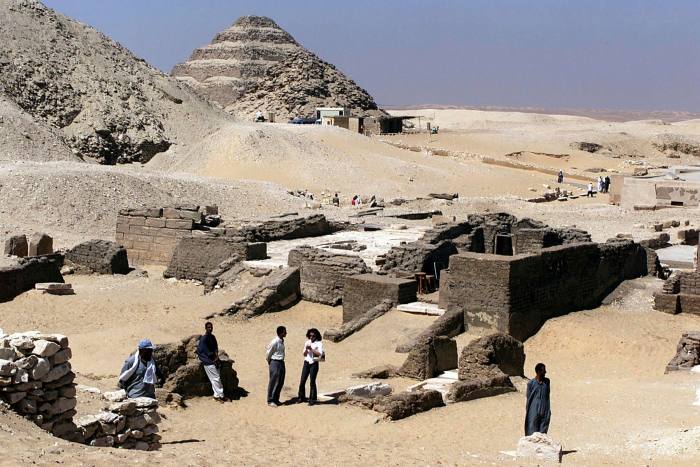A vast desert site on the southern outskirts of Cairo, Egypt’s Saqqara necropolis is one of the richest Pharaonic sites in the country, boasting spectacular monuments such as the earliest known pyramid in Egyptian history as well as the tombs of kings, high officials and sacred animals.
After a spate of discoveries this year, Egyptologists say the 5,000-year old site has not yielded all its treasures and much remains to be discovered.
Large caches of sealed ancient coffins — painted with brightly coloured scenes, still intact and containing well-preserved mummies — were discovered in October, untouched since burial millennia ago.
“What we see above ground is no more than 40 per cent of what exists below ground,” said Mostafa Waziri, head of the Supreme Council for Antiquities who led the Egyptian teams that made the latest discoveries.
“Saqqara is very rich, and there is still more to find. I think we can work on it for another hundred years.”

Not far from the Pyramids of Giza and adjacent to the ancient capital city of Memphis, Saqqara was used as a burial ground for millennia.
King Zoser, who ruled more than 4,600 years ago, built his step pyramid there and it remains a landmark rising above the site. It is the earliest pyramid and first stone building known in Egyptian history.
“Once Zoser was buried there, Saqqara became even more important because there was a greater reason for people to choose to be buried there to benefit from the blessings of the king,” said Salima Ikram, professor of Egyptology at the American University in Cairo. “It remained a cemetery way into the 8th century AD.”
Mr Waziri points to remarkable archaeological discoveries in Saqqara in the past two years including the decorated tomb of Wahte, a priest who lived in the 25th century BC, caches of gilded statues and unusual finds such as a mummified scarab and an embalmed lion cub.
The recently discovered coffins date back to what is termed the Late Period from about 664BC to 332BC. and some are from the subsequent Ptolemaic dynasty which ruled until the death of Cleopatra, its last queen, in 30BC.

The decorations on some of the coffins, said Mr Waziri, especially those from a trove of about 100 announced in November, suggest they belonged to high officials and senior figures.
In a year in which the pandemic has decimated Egypt’s tourism industry, officials have celebrated the new discoveries with big events, inviting diplomats and media to highlight the country’s riches.
The coffins will be exhibited at a series of new museums, including one in the Red Sea resort of Sharm el-Sheikh and in the huge Grand Egyptian Museum in Cairo which is due to open in 2021. Tourist arrivals in Egypt in 2020 dropped to 3m, less than a quarter of the record 13m who visited the year before, according to official figures.

A television broadcast in recent days showed Mr Waziri being lowered into another burial shaft from which the coffins have not been removed. They appear stacked in layers around him covered in millennia-old dust, which he uses a brush to flick away to unveil colourful decorations.
Zahi Hawass, a renowned Egyptian archeologist who is working on another excavation in Saqqara, expects to announce new finds in early 2021. These too are coffins but this time from the New Kingdom — and therefore an even older era than the artefacts unearthed in recent months. “Saqqara was a stomping ground of kings,” he said. “Tutankhamun lived and died near here.”
The burial shafts were found in a part of Saqqara called the Bubasteion which once included a temple complex dedicated to Bastet, a goddess of love, beauty and motherhood depicted in the form of a cat. The coffin caches could contribute enormously to our understanding of the ancient Egyptians, argued Ms Ikram.
“If we look at the contents of each shaft in its entirety and compare the texts on the coffins, we could tell if the people inside are related because of bloodlines, trade and priestly association,” she said.
“We can also learn about coffin manufacture, the beliefs shared and if they were related to the cult of Bastet. It would be excellent if qualified scholars have a chance to examine the material and, most importantly, to publish it.”
"still" - Google News
December 25, 2020 at 12:00PM
https://ift.tt/34JAw2a
Egypt uncovers Pharaonic treasure trove: ‘There is still more to find’ - Financial Times
"still" - Google News
https://ift.tt/35pEmfO
https://ift.tt/2YsogAP
Bagikan Berita Ini














0 Response to "Egypt uncovers Pharaonic treasure trove: ‘There is still more to find’ - Financial Times"
Post a Comment